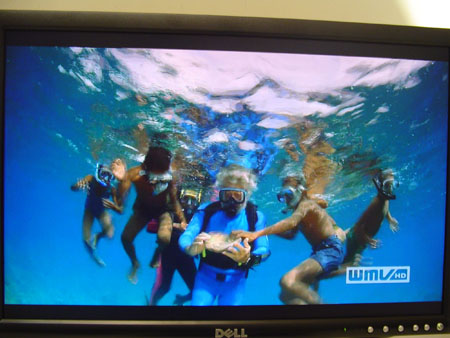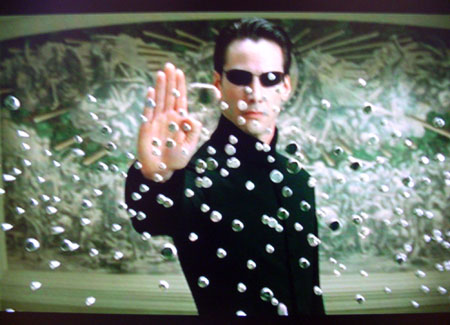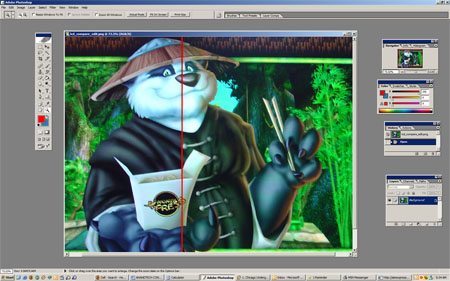The 20" LCD Shootout: Dell versus Apple
by Kristopher Kubicki on April 27, 2005 12:05 AM EST- Posted in
- Displays
Application Analysis
The core of our LCD benchmarking comes from real application analysis. We play with a lot of monitors and it gets easier for us each time to pick out problems with an LCD just by using the right application. Here are a few quick looks at some demanding full screen applications. We already ran ColorVision's OptiCal software, so all of our monitors are calibrated and adjusted to the same curves.High Definition Video – We played the WMV9 1080p and 720p versions of “Under Sea Adventure” to give our monitor a little taste of high definition video. In many of our previous analyses, we simply ran WMV9 content unscaled to test color depth and clarity. However, since both the Apple Cinema and Dell 2005FPW are capable of widescreen unscaled aspect ratios (at least for 720p), we thought it best to put both of these monitors completely through their paces. No surprise, but there doesn’t seem to be any corruption or shifts in any of the colors. However, keep in mind that neither of these displays supports HDCP! We could not watch 1080i or 720p signals on either display from a regular Comcast HD receiver, since neither display has a DVI-HDCP input. While pin compatible, any HDCP source simply terminates after a few seconds of video. The Dell 2005FPW has a few additional inputs, so we can actually use a component-to-VGA (15-pin D-sub) cable and watch HD content in this manner. Of course, for the same reason why we don’t encourage anyone to use 15-pin D-sub cables for regular computer use, we really don’t recommend D-sub for TV either if it can be avoided. Unfortunately, in this scenario, it cannot.
The Matrix Reload, The Matrix - We use the Matrix series to test full motion video on our LCDs. Since the Matrix isn't the best movie to test color reproduction, we typically only look for motion blur on gray-to-gray transitions or other imperfections in the signal. Both displays demonstrated accurate sharpness, although we noticed that the slightly duller Apple display had more of a “washed out” look to it in comparison to the Dell 2005FPW. Typically, we only see this on brighter LCDs with lower contrast ratios. Since the Apple 2005FPW has a (very) slight lower measured contrast ratio, this didn’t surprise us during out testing.
World of Warcraft – Although I didn’t personally start playing World of Warcraft until Anand published his Performance Guide, WOW happens to be one of the most perfect games to test LCD gaming. The fairly rich color palette, high motion objects and often contrasting lights and darks make the game a perfect haven to really put a display to its limits. (Unfortunately, once you turn it on, it also becomes nearly impossible to stop playing and start writing). Putting our displays into mirroring mode and playing for a few hours really stresses the importance of good color calibration in game settings; for example, it became almost impossible to differentiate portions of the grass needed to be selected for a quest on both LCDs before calibration through ColorVision’s OptiCal. Because both monitors were using DVI connectors, these changes had to be made to the color curves on the PC because the functionality is disabled on the monitors.
Max Payne 2 - The extreme light and dark transitions in Max Payne still provide us with the sufficient criteria to benchmark transient response time; specifically, we can focus on the light and dark extremes. We detected no red shift (as we usually do on this game for PVA displays), and had no problem with motion blur.
Photoshop CS – We typically don’t mention applications like Photoshop, but while using some of our new found desktop space, we took to advanced features in Photoshop like a fish in water. It’s no surprise that high end graphics (and, of course, video) are done on these displays; the higher resolution and wider room allow us to spread the tool bars out further while giving us more room to work. Widescreen displays feel awkward at first, but given hours of tinkering and readjusting, the additional room feels almost necessary.













70 Comments
View All Comments
jediknight - Wednesday, April 27, 2005 - link
Only thing I really don't like about Dell is their dead pixel policy. They will only replace a monitor (so I've been told) if it has 6 dead pixels.Personally, ONE dead pixel is too many!
crimson117 - Wednesday, April 27, 2005 - link
Dell's brand is called "UltraSharp", not "UltraSync" as the review states. NEC's brand is called MultiSync, maybe that got confused?mlittl3 - Wednesday, April 27, 2005 - link
Here are the final prices (retail not education of both of these monitors).Apple $799
Dell $486.85
Apple just today reduced the price of their LCD panels. Also, it should be noted that the Dell LCD is listed as $749 but a 35% discount lowers the price.
This is a perfect example of how hardware costs the same between PC and Mac but volume shipments allow a distributor to lower the cost considerably.
Apple is selling a lot less of these than Dell therefore their prices are higher. Both panels still cost about the same before volume shipments are factored in. If the whole world buys Apple, then Apple would sell the LCD for $499 and Dell would increase the price to $749.
Gotta love capitalism!
DCstewieG - Wednesday, April 27, 2005 - link
#17 How did you get that $799 price? I followed the link and the session was expired but then I went back to the store and sure enough...$799. Even with my educational discount it's $899.Though even @ $799, my point stands.
JNo - Wednesday, April 27, 2005 - link
Superb...Agree that other connections (s-vid, composite) should be tested via eg xbox... shame no component...
Am really tempted to get widescreen now that games are beginning to support it or can be made to support it. More elegant than dual monitor and better for movies/games too. Really impressed that the Dell 'out-functioned' the Apple with similar/better performance too.
On the Dell 2405 (1920x1200), does anyone know what panel it uses? LG Philips too?
Also anyone know if
a) it supports 1:1 pixel scaling?
b) it can be bought in UK (does not appear on dell uk website) - and how much?
c) it can also rotate to portrait mode?
Thks
smn198 - Wednesday, April 27, 2005 - link
#2112ms typical (Grey to Grey) / 16ms typical (Black to White)
http://support.dell.com/support/edocs/monitors/200...
Guess Dell are slightly schizophrenic
sandys - Wednesday, April 27, 2005 - link
Quite a few games that don't support widescreen natively can be modified to do so, check out http://www.widescreengamingforum.com/ for details, I have a 2405 and run all my games in widescreen with the correct aspect ratio.Cheers
blwest - Wednesday, April 27, 2005 - link
Nice article. I bought two of these in Feb and absolutely agree with everything in this article. I do think that WOW supports 16:10 though. I'm not 100% certain until I get home but I've been playing it and nothing is deformed. In soviet russia, the monitor watches you.segagenesis - Wednesday, April 27, 2005 - link
Impressive display but I personally dont like the fact its 16:10... why not 16:9? Did I miss the memo on how LCDs are manufacturered? Having a Trinitron CRT im still hard pressed to want to move to LCD especially for games.toyota - Wednesday, April 27, 2005 - link
Dell does NOT claim 12ms response time!! I am looking at their catalog that i got a few weeks ago and it lists 16ms for response time for the 2005FPW!!